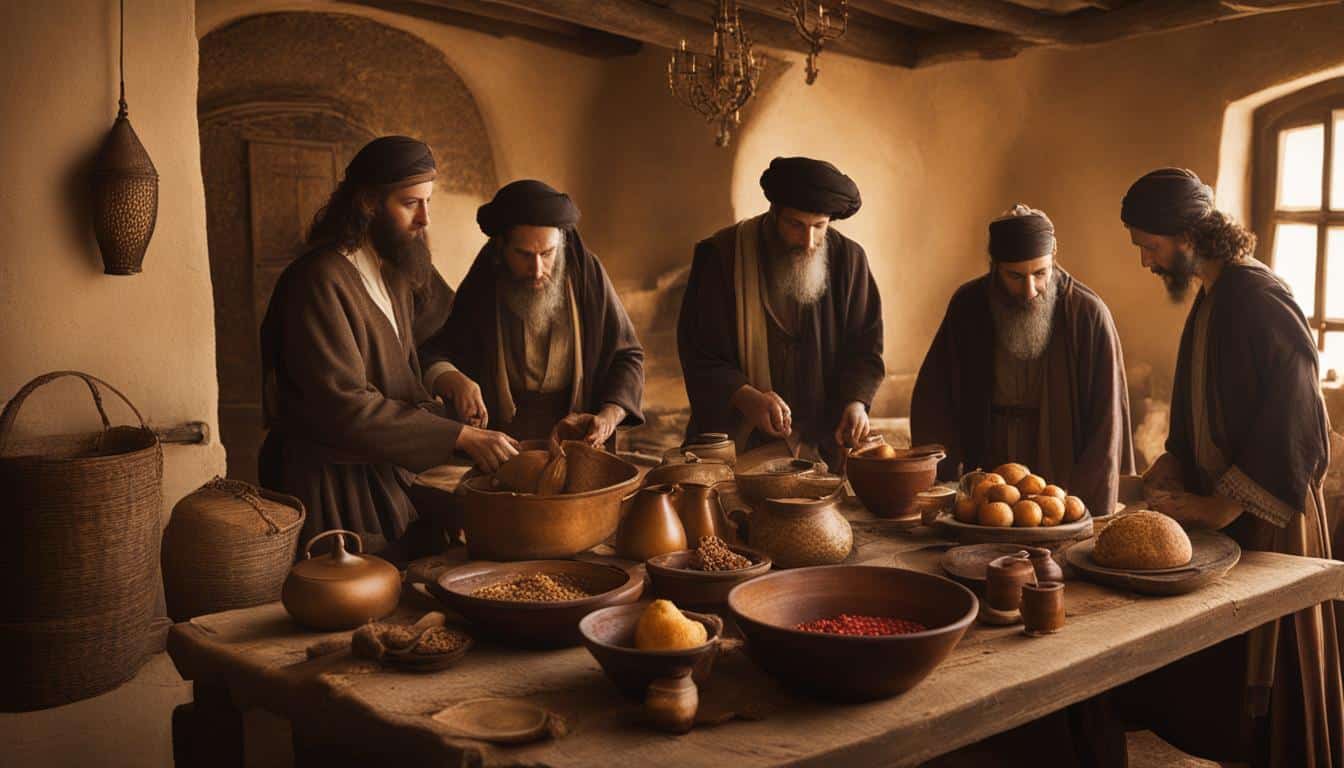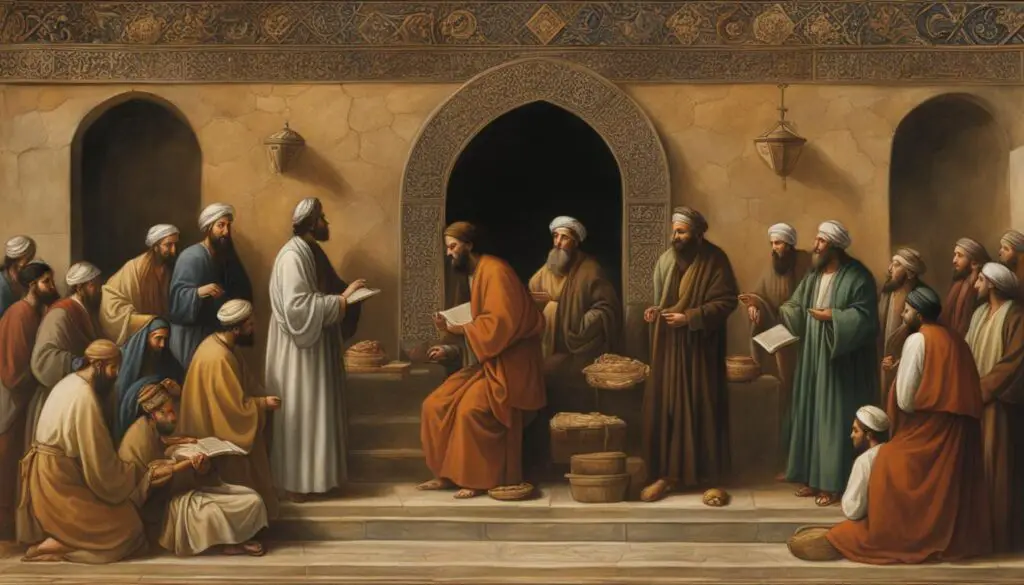
Welcome to my comprehensive study on Jewish traditions during the time of Jesus. In order to fully understand the historical context of Judaism and Christianity, it is essential to delve into the practices and rituals that characterized the era when Jesus lived. From the diverse sects of Judaism to the influence of these traditions on Jesus’ teachings, this article will explore the rich tapestry of Jewish culture during this period.
Key Takeaways:
- Jewish traditions during the time of Jesus played a crucial role in shaping the religious and cultural landscape of the first century.
- Common practices like following dietary restrictions, observing the Sabbath, and participating in Temple worship unified the diverse Jewish groups.
- Judaism heavily influenced Jesus’ teachings, as he drew upon Jewish scriptures and traditions to convey his message.
- The first century was marked by the presence of various Jewish sects, each with its own interpretations and practices.
- Understanding the diversity of these sects provides valuable insights into the social and religious context in which Jesus lived and ministered.
Influence of Judaism on Jesus’ Teachings
Judaism played a significant role in shaping the teachings of Jesus during his ministry. Growing up within the Jewish culture and tradition of his time, Jesus drew upon Jewish scriptures and traditions, reinterpreting them in ways that resonated with his audience. He engaged in debates with religious leaders, particularly the Pharisees, discussing topics related to Jewish rituals and observances.
Jesus emphasized the importance of love, compassion, and justice in his teachings, aligning with the core values of Judaism. He upheld the commandments and ethical teachings found in Jewish scriptures, challenging his followers to treat others with fairness and honesty. In his actions, Jesus performed miracles that mirrored those of Jewish prophets, displaying healing powers and even raising the dead.
While Jesus respected Jewish traditions, he also sought to shift the focus from external rituals to internal spiritual transformation. He emphasized that true righteousness comes from the heart rather than mere adherence to religious practices. This distinction set Jesus apart from the religious authorities of his time and continues to influence both Christianity and Judaism to this day.

Overall, the influence of Judaism on Jesus’ teachings cannot be overstated. His understanding of Jewish scriptures, his engagement with religious leaders, and his embodiment of Jewish values all contributed to the unique message he preached. By examining the significance of Jewish traditions in Jesus’ ministry, we gain a deeper understanding of the historical and cultural context in which his teachings took place.
The Diversity of Jewish Sects in Jesus’ Time
The first century Jewish culture was a vibrant tapestry of diverse sects and beliefs, providing valuable insights into the religious and cultural context in which Jesus lived and ministered. Besides the well-known sects like the Pharisees and Sadducees, there were other groups such as the Essenes, Zealots, and followers of charismatic leaders. Each sect had its own interpretations of Jewish scriptures and practices, contributing to the rich mosaic of ancient Jewish culture and traditions.
The Pharisees were known for their strict observance of religious laws and traditions. Their emphasis on the meticulous adherence to the Law shaped their interactions with Jesus, often engaging him in debates and discussions about religious practices.
On the other hand, the Essenes chose to live an ascetic lifestyle, withdrawing from mainstream society to seek a deeper spiritual connection. Their isolation influenced their belief system and practices, showcasing the diversity within Jewish society during that time.
It is crucial to emphasize that most Jews did not belong to any specific sect but shared common Jewish practices and beliefs. The dynamic interplay and coexistence of these diverse sects not only influenced Jewish customs in the first century but also set the backdrop for the ministry of Jesus.
FAQ
What were the main sects of Judaism during the time of Jesus?
The main sects of Judaism during the time of Jesus were the Pharisees, Sadducees, Essenes, Zealots, and Sicarii.
Were there other belief systems besides these sects?
Yes, besides the main sects, there were other groups such as followers of John the Baptist and followers of Jesus of Nazareth.
What were some common practices among Jews at the time of Jesus?
Common Jewish practices during that time included following dietary restrictions (kashrut), observing the Sabbath, and worshiping at the Temple in Jerusalem.
Can you explain what kashrut is?
Kashrut, or keeping kosher, is a set of dietary regulations that includes separating meat and dairy and avoiding unclean foods like shellfish and pork.
What role did the Temple in Jerusalem play in Jewish life at that time?
The Temple, built by Herod the Great, served as the center of Jewish life and worship during that time. It was a focal point for ritual animal sacrifices and a place of pilgrimage for Jews.
How did Judaism influence Jesus’ teachings?
Being raised within the Jewish culture and tradition, Jesus often referenced Jewish scriptures and traditions, interpreting and reimagining them in ways that resonated with his audience.
Who were the Pharisees and what was their role in Jesus’ ministry?
The Pharisees were known for their strict adherence to Jewish law. They engaged Jesus in debates and discussions about religious practices.
Did Jesus follow the Jewish religious laws?
Yes, Jesus upheld the commandments and ethical teachings found in Jewish scriptures. He emphasized the importance of love, compassion, and justice in his teachings.
Did Jesus perform miracles similar to Jewish prophets?
Yes, Jesus performed miracles that mirrored the actions of Jewish prophets, such as healing the sick and raising the dead.
How did the diverse Jewish sects contribute to the cultural and religious landscape of Jesus’ time?
The diversity of Jewish sects, including the Pharisees, Sadducees, Essenes, and Zealots, contributed to the rich tapestry of Jewish culture and belief during Jesus’ time.
How were Jewish customs influenced by the Roman occupation?
Jewish society during that time was heavily influenced by the Roman occupation and the political and social upheavals that followed, which inevitably had an impact on Jewish customs and practices.








